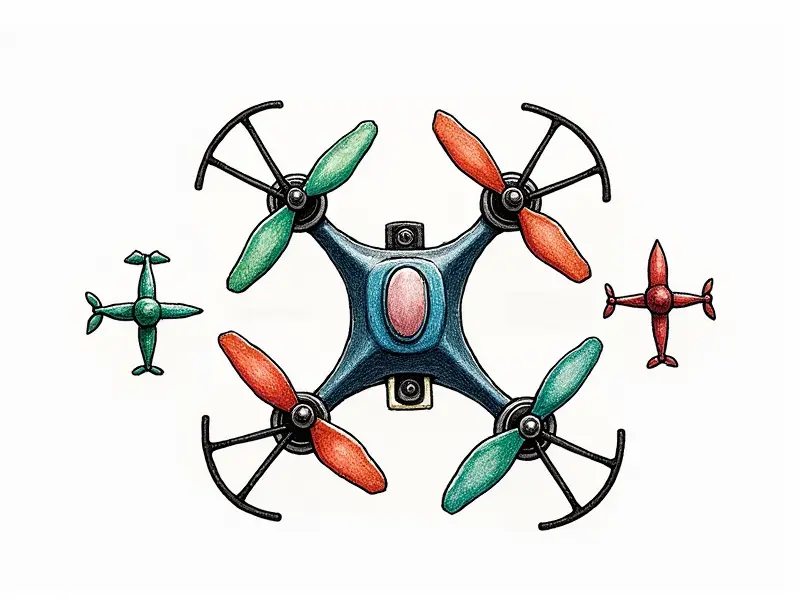How do I control my drone?

Mastering Drone Controls in Minutes
Welcome to the world of drone flying! Whether you're a beginner or looking to refine your skills, mastering drone controls is essential for safe and enjoyable flights. This guide will walk you through the basics and help you become proficient quickly.
Learn Drone Flight Basics Quickly
Before taking off, it's crucial to understand the fundamental aspects of drone flight. Familiarize yourself with your drone’s control system, whether it's a traditional remote or an app-based interface.
- Throttle: Controls the altitude and speed of ascent/descent.
- Ailerons/Roll: Moves the drone left and right.
- Elevators/Pitch: Tilts the drone forward or backward.
- Rudder/Yaw: Rotates the drone clockwise or counterclockwise.
Quick Start Guide: Drone Controls Explained
To get started, follow these simple steps to familiarize yourself with your drone's controls:
- Setup: Ensure your drone is properly assembled and charged. Connect the remote control to the drone.
- Pre-flight Checks: Conduct a visual inspection of the drone, check battery levels, and ensure all propellers are securely attached.
- Lift-off: Slowly increase throttle until the drone lifts off the ground. Maintain a steady altitude for practice.
Beginner's Guide to Drone Navigation
Navigating your drone effectively is key to capturing great footage and avoiding obstacles. Here are some navigation tips:
- Use GPS: Enable GPS if available, as it helps stabilize the drone’s position.
- Obstacle Avoidance: Keep an eye out for trees, buildings, or other objects that could interfere with your flight path.
- Practice Hovering: Master hovering in place to improve stability and control.
How to Navigate Your RC Quadcopter
Navigating an RC quadcopter requires a bit more finesse than basic drone flying. Here are some advanced techniques:
- Yaw Control: Learn to rotate the drone precisely for smooth turns and maneuvering.
- Precision Landing: Practice landing in tight spaces or on specific targets.
- Obstacle Courses: Create your own obstacle course using cones or markers to enhance navigation skills.
Learn to Fly FPV Racing Drones Easily
Flying FPV (First-Person View) racing drones is exhilarating but requires specialized techniques:
- FPV Goggles: Use high-quality goggles for a clear, immersive view.
- Racing Lines: Plan your flight path ahead of time to optimize speed and agility.
- Practice Drills: Engage in regular practice sessions to improve reaction times and control precision.
Essential Skills for Controlling RC Drones
To become a skilled drone pilot, focus on these essential skills:
- Manual Control: Learn to fly without GPS assistance for more precise maneuvers.
- Sensor Calibration: Regularly calibrate sensors like accelerometers and gyroscopes for optimal performance.
- Battery Management: Understand battery life indicators and manage power efficiently during flights.
Easy Tricks to Master Drone Flight Controls
Making your drone perform cool tricks can be a lot of fun. Here are some easy-to-learn maneuvers:
- Circle Stunts: Make the drone fly in circles, adjusting speed and direction.
- Airborne Photography: Capture stunning aerial shots by moving your drone through various angles.
- Hovering Tricks: Practice hovering at different heights and performing flips or rolls from a hover position.
Top Drone Flying Tips for Beginners
Becoming proficient in drone flying takes time and practice. Here are some tips to help you along the way:
- Start Indoors: Begin your flight training indoors where there's less wind interference.
- Limited Flight Zones: Start with small, enclosed areas before moving on to larger open spaces.
- Video Tutorials: Watch online tutorials and practice sessions for additional guidance and inspiration.
Perfect Your Drone Flight Techniques Today
To refine your drone flying skills, focus on these techniques:
- Smooth Transitions: Practice transitioning smoothly between different flight modes and maneuvers.
- Precision Flying: Work on precise movements to capture detailed shots or navigate tight spaces.
- Safety First: Always prioritize safety by checking weather conditions, avoiding restricted areas, and following local regulations.
Droning Made Simple: Control Basics
Mastery of drone controls is the foundation for all other skills. By understanding and practicing these basic principles, you'll be well on your way to becoming a skilled pilot:
- Understand Your Equipment: Know how each button or joystick affects the drone’s movement.
- Familiarize with Flight Modes: Learn about different flight modes and their applications.
- Continuous Practice: Regular practice is key to improving your skills and confidence in flying.
Conclusion
Mastery of drone controls is not only essential for safe operation but also opens up a world of creative possibilities. By following this guide, you'll be well-equipped to handle various types of drones and navigate challenging scenarios with ease. Keep practicing, stay curious, and enjoy the thrill of flying!

